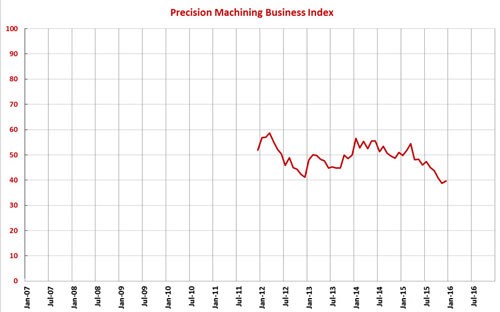Precision Machining Business Index: December 2015 - 39.7
Future business expectations have improved significantly in the previous 2 months.

With a reading of 39.7, the Gardner Business Index showed that the precision machining industry contracted for the ninth month in a row. However, December was the first month since July that the index contracted at a slower rate.
New orders have contracted nine consecutive months. In December, they contracted at a noticeably slower rate than the previous month. But, the new orders index was under 40 for the fourth month in a row. Production contracted for the seventh straight month. The index improved from the previous month, but was under 40 for the third month in a row. Generally, the new orders index has been lower than the production index for the previous 21 months. Therefore, the backlog index contracted for the 16th month in a row. While the backlog index has been quite low, it has stabilized in recent months. Employment contracted for the fifth consecutive month. Because of the strong dollar, the export index has contracted since March 2014. In December, the export index fell to its lowest level since the survey began in December 2011.
Supplier deliveries shortened for the fourth month in a row. The trend in supplier deliveries indicated slack within the supply chain since suppliers were more able to meet customers’ needs.
The material prices index contracted for the sixth month in a row. The index has declined since June 2014, and it has been in a virtual free fall since June last year. Prices received at machine shops decreased for the fifth time in 7 months. Prices received decreased at a somewhat slower rate than in November, though. Future business expectations have improved significantly in the previous 2 months.
Facilities with more than 250 employees have contracted six times in the previous 7 months. In two of those months, the index was below 30. After 3 straight months of contraction, plants with 100-249 employees expanded at their fastest rate since March last year. Mid-size facilities, those with 20-99 employees, have contracted at a fairly consistent rate since September. Companies with fewer than 20 employees continued to struggle. Their index fell to its lowest level since the survey began in December 2011.
All six regions contracted in December. The Southeast contracted at the slowest rate, although the Northeast and the West were not far behind. Both the North Central-East and North Central-West had an index below 40. The South Central had an index below 30 for the second month in a row.
Future capital spending plans fell to their lowest level since the survey began, which was almost 50 percent below the historical average. Compared with 1 year ago, capital spending plans contracted at their fastest rate since the survey began.



.JPG;width=70;height=70;mode=crop)
